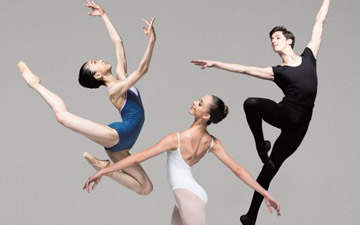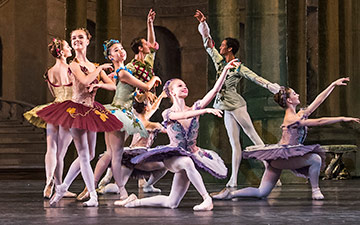
© Emma Kauldhar. (Click image for larger version)
English National Ballet School
2019 Summer Performance – Celebrating 30 Years
★★★✰✰
London, New Wimbledon Theatre
5 July 2019
www.enbschool.org.uk
newwimbledontheatre.net
English National Ballet School is celebrating 30 years since its inception in 1989 – it had just 12 students in that inaugural year. The intention was for it to become a feeder school for English National Ballet and in the last three decades, many of the students have gone on to rise through the ranks, from corps to soloist and to lead principal. The numbers are ever increasing and there is evidence of significant talents among the graduates this year. However, there is a certain unevenness across year groups, arguably to be expected when students arrive from all over the world, with different training and backgrounds.
This was not apparent though in Taina Morales’ excerpts from Giselle Act II. Based on Alicia Alonso’s version for Cuban National Ballet, not one I am overly familiar with, in terms of the execution and clarity of the corps de ballet, it was very polished indeed. Uniformly musical, with very good arabesque shunts across the stage, clear arms, hands and neat footwork – this was a crisply cool band of Wilis. As Zulme and Moyna, Zoe Brady and Phillipa McCann gave thoughtful, ghostly accounts of their solos and Katherine Lee was assured as Myrtha. Lovely arabesque lines and soft landings (not a clompy pointe shoe within earshot) were notably pleasing, but a Queen of the Wilis without an entrechat six or flying six, is slightly disappointing. Not her fault.

© Emma Kauldhar. (Click image for larger version)
Overture from Die Zauberharfe with choreography by Carlos Valcárcel, was a very confident display of neo-classical technique. Led by Chloe Keneally, Beatriz Kuperus and Harvey Littlefield, it was impressive both in solo and pas de deux work. After a short pause, Keneally came into her own in a solo choreographed by Kenneth Tindall – she was a contestant in this year BBC Young Dancer competition and danced this piece (and others) in that. She’s more than ready to embark on a professional career and this excellent creation showed off her versatility and maturity. Four short pieces followed which were created by winners of the school choreographic competition. Good to see that this is being encouraged throughout the school but as yet, no startling revelations. The first half finished with an extract from José Agudo’s A Thousand Shepherds. It was very well danced by all and good to see that students can show such a command of the contemporary genre but most outstanding, was Wesley Brand who gave a terrific performance leading the group. He has a very strong stage presence, combined with good technique and partnering and a highly distinctive timbre to his movement.

© Emma Kauldhar. (Click image for larger version)
The second half opened with Valcárcel’s Pas de Garçons and finished with excerpts from Paquita, both of which are exceedingly challenging. Pas de Garçons presented 31 one male students (and briefly 5 females) in a classical classroom setting. While it gave them ample opportunity to prove their spirit and tenacity and in many cases, their mastery of tricks with plenty of pluck, it also exposed, rather shamelessly, the weaknesses of those less able. It was too long and while the premise of showcasing the men in this way, was admirable, the outcome proved overambitious. Brand, Littlefield and Eric Snyder were among those who came off best.

© Emma Kauldhar. (Click image for larger version)
Paquita too, overstretched some of the students but happily, Paquita and Lucien D’Hervilly, Kuperus and Littlefield respectively did an extremely good job in the leading roles. He looks to be a very attentive and strong partner, achieving unwavering présages and an obvious feel for securing his ballerina’s balance. He also has the height and demeanour of a prince, which can only help him in the future. Kuperus has lovely legs and feet, thrilling pirouettes and a vibrant stage presence. A little more focus on her hands and the detail of neat finishes and she will go far.
Other mentions must be for the worthy Pas de Trois of Maeve Nolan, Ritsuko Ogino and Snyder once again, who gave it their all. Ogino in particular paid attention to the phrasing which gave her an edge. There was certainly no shortage of talent but perhaps, particularly in the second half, the secret to success is that less is sometimes more.

















You must be logged in to post a comment.